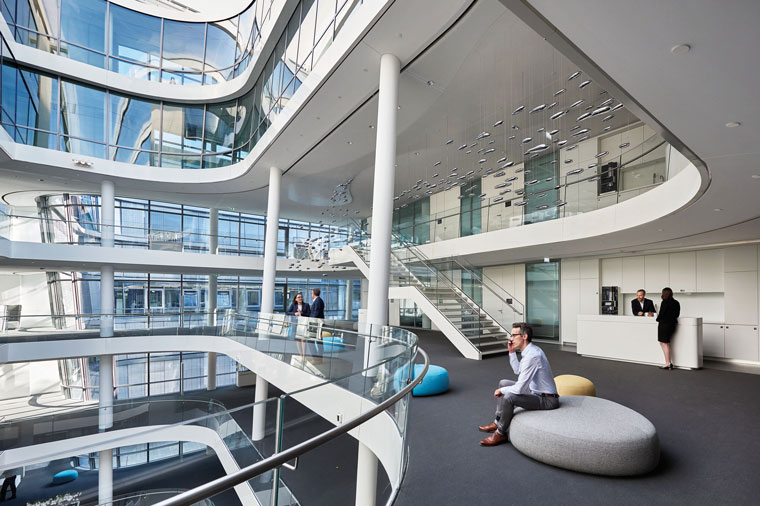Siemens has been using its own smart building tech and other software to ensure that workers can collaborate during the lockdown.

By:
Eric De Grasse
Chief Technology Officer
24 July 2020 (Paris, France) – Siemens is embracing flexible work policies (and will use what it learns to sell remote tools to other enterprises). As we have and many others have noted, the coronavirus pandemic has pushed more companies to evaluate their current office environments. But while there’s been a ton of talk about remote work becoming “the new normal”, changing more than a century of office work is a daunting task.
Siemens, however, is going to try, and I think they are serious. The company has announced that it will embrace a hybrid of remote and in-office work based on the legal requirements of the countries where employees live, the demands of the jobs being performed, and employee-specific preferences.
As we have noted in previous posts (full disclosure: Siemens is a client of our founder’s media company), Siemens has been using its own smart building tech and other software to ensure that workers can collaborate during the lockdown, which will undoubtedly help it package up compelling software to sell to other large companies that are coming to similar conclusions about the future of work.
The company will establish mobile working as a core component of its “new normal” and will make it a permanent standard, both during the global pandemic and beyond. The company’s Managing Board has now approved implementation of a corresponding model. The aim is to enable employees worldwide to work on a mobile basis for an average of two or three days a week, whenever reasonable and feasible. In an interview, Roland Busch, Deputy CEO and Labor Director of Siemens AG, noted:
The coronavirus crisis and social distancing measures have shown that working independently of a fixed location offers many advantages and is possible on a much wider scale than originally thought. Worldwide surveys of Siemens’ employees confirmed their desire for greater flexibility and for personalized solutions when it comes to deciding where they work.
Here, mobile working explicitly means more than just working from home. Instead, employees – in consultation with their supervisors – are to choose the work locations where they’re most productive. As a result, the hybrid working model specifically includes working environments such as coworking spaces. Work in person at the office is to supplement mobile working as appropriate.
The coronavirus crisis has triggered a surge in digitalization. We’ve always had mobile working at Siemens, but now we’re taking it a step further. The basis for this forward-looking working model is further development our corporate culture. These changes will also be associated with a different leadership style, one that focuses on outcomes rather than on time spent at the office. We trust our employees and empower them to shape their work themselves so that they can achieve the best possible results. With the new way of working, we’re motivating our employees while improving the company’s performance capabilities and sharpening Siemens’ profile as a flexible and attractive employer.
A project team comprising employees from Strategy, Human Resources, and IT and Siemens Real Estate as well as representatives from the businesses developed the New Normal Working Model during the coronavirus pandemic. This new model applies to more than 140,000 of the company’s employees at over 125 locations in 43 countries and is effective immediately. The rights of employee representatives regarding implementation in the various countries will, of course, be upheld. Said Jochen Wallisch, Head of Industrial Relations & Employment Conditions at Siemens AG’s Human Resources department, in a press release:
The New Normal Working Model fits seamlessly into our concept for the future of work. We’re using this model to pursue the goal of developing new ways of working together on a mobile, digital basis. The new normal will also strengthen our ability to recruit and retain the best talent for Siemens and to increase diversity on our teams.
The approach will be tailored to local legal requirements, the demands of various job profiles, and individual preferences. It will be founded on mutual consultations between employees and their supervisors. A centralized IT platform will provide supervisors and employees with all relevant information regarding the new work model, and specific training sessions for supervisors will support the model’s launch. In a separate interview, Hanna Hennig, Chief Information Officer of Siemens AG, added:
I am pleased that we have developed a bespoke app solution.
Thanks to our innovative cloud-based IT infrastructure, we were able to scale our services quickly and smoothly in order to put 300,000 employees in a position to work from home. With more than 800,000 online meetings per day, we are already enabling them today to collaborate effectively without being at the same location. I am pleased that we have developed a bespoke app solution for Siemens, based on a solution our Smart Infrastructure Operating Company already had available, that supports our employees worldwide in safely returning to their workplaces and in implementing the new forms of work effectively.
[ To read this post on our blog, along with our other articles, consult out archive by clicking here ]